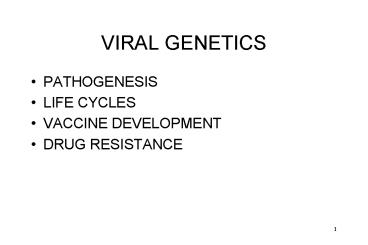VIRAL GENETICS PowerPoint PPT Presentation
1 / 37
Title: VIRAL GENETICS
1
VIRAL GENETICS
- PATHOGENESIS
- LIFE CYCLES
- VACCINE DEVELOPMENT
- DRUG RESISTANCE
2
VIRAL GENETICS
DNA chromosomes of eukaryotic host organisms
generally require geologic time spans to evolve
to the degree that their RNA viruses can achieve
in a single human generation.
3
VIRAL GENETICS
- VIRUSES GROW RAPIDLY
- A SINGLE PARTICLE PRODUCES A LOT OF PROGENY
- DNA VIRUSES SEEM TO HAVE ACCESS TO PROOF READING,
RNA VIRUSES DO NOT SEEM TO
4
NATURE OF GENOMES
- RNA or DNA
- SEGMENTED OR NON-SEGMENTED
5
GENETIC CHANGE
- MUTATION
- RECOMBINATION
6
ORIGIN OF MUTATIONS
- SPONTANEOUS
- tautomeric form of bases
- polymerase errors
7
Tautomeric forms of bases
most of time
rarely
8
ORIGIN OF MUTATIONS
- SPONTANEOUS
- tautomeric form of bases
- polymerase errors
mutation rates usually higher in RNA viruses
(lack of proof reading)
why do some viruses seem to alter very little,
even though one would expect high mutation rates?
9
ORIGIN OF MUTATIONS
- SPONTANEOUS
- PHYSICALLY INDUCED
- UV light , especially problem if no access to
repair - X-rays
- CHEMICALLY INDUCED
10
TYPES OF MUTATION
- POINT
- INSERTION
- DELETION
11
PHENOTYPES
- PHENOTYPE
- the observed properties of an organism
12
PHENOTYPIC CHANGES
- CONDITIONAL LETHAL - multiply under some
conditions but not others - wild-type (wt) grows
under both sets of conditions - temperature-sensitive (ts) mutants do not grow at
higher temperature (altered protein) - host-range mutants do not grow in all the cell
types that the wt does
13
PHENOTYPIC CHANGES
- PLAQUE SIZE
- may show altered pathogenicity
- DRUG RESISTANCE
- important in the development of antiviral agents
- ENZYME-DEFICIENT MUTANTS
- some genes can be optional in certain
circumstances
14
PHENOTYPIC CHANGES
- HOT MUTANTS
- grow better at elevated temperature than wt
- less susceptible to host fever response
- ATTENUATED MUTANTS
- milder (or no) symptoms
- vaccine development
- pathogenesis
15
GENETIC CHANGE
- MUTATION
- RECOMBINATION
16
RECOMBINATION
- Exchange of information between two genomes
17
RECOMBINATION
- classic recombination
common in DNA viruses
18
COPY CHOICE RECOMBINATION
- ve strand 1
- ve strand 2
19
COPY CHOICE RECOMBINATION
- ve strand 1
- ve strand 2
20
COPY CHOICE RECOMBINATION
- strand
- strand
- - strand
21
COPY CHOICE RECOMBINATION
- strand
- strand
22
Other methods recombination
- Take advantage quirks in virus replication
- eg. Coronaviruses (include SARS virus)
23
RECOMBINATION - SOME USES
- mapping by recombination frequency
- mapping by marker rescue
24
RECOMBINATION - SOME USES
marker rescue
- TK - mt
- TK mutant HSV
25
RECOMBINATION - SOME USES
- mapping by recombination frequency
- mapping by marker rescue
- development of recombinant viruses for vaccines
and therapeutic reasons
26
RECOMBINATION - SOME USES
- TK
- vaccinia virus
- T
- K
- rabies G
- vaccinia virus for use
- as rabies vaccine
- rabies G
27
raccoon eating bait with rabies vaccine in it
28
REASSORTMENT
29
REASSORTMENT
- form of recombination (non classical)
- very efficient
- segmented viruses only
- used in some new vaccines
30
INFLUENZA VIRUS
- cold adapted
- temperature-sensitive
- attenuated
- live vaccine
- intranasal delivery
- approved 2003
adapted fromTreanor JJ Infect. Med. 15714
31
NON-SEGMENTED NEGATIVE STRAND RNA VIRUSES
- no classical recombination
- no copy choice
- no reassortment
- least ability to exchange genetic material
32
COMPLEMENTATION
- Interaction at the functional level, NOT the
nucleic acid level
Progeny virus assembled using wt N and wt M
proteins Genomes in progeny are either ts M or ts
N
mutants which can complement are generally in
different genes
33
DEFECTIVE VIRUSES
- lack gene(s) necessary for a complete infectious
cycle - helper virus provides missing functions
34
DEFECTIVE VIRUSES
- some examples of defective viruses
- some retroviruses (use related helper)
- hepatitis delta virus (uses unrelated helper)
35
DEFECTIVE INTERFERING (DI) VIRUSES (PARTICLES)
- decrease replication of helper virus
- compete for viral precursors, etc.
- may modulate wt infections
- occur naturally eg. DI measles virus in subacute
scelerosing panencephalitis - SSPE
36
PHENOTYPIC MIXING
no changes in genome possibly altered host
range possibly resistant to antibody
neutralization
37
PHENOTYPIC MIXING
- PSEUDOTYPE

